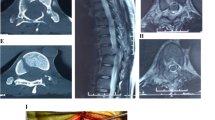Abstract
We compared clinical outcomes following conservative treatment of subaxial fracture dislocations of the cervical spine and posterior fusion using bone grafts and interspinous Roger’s wiring (Bohlman modification). We reviewed 106 patients: 51 were treated primarily surgically, and 55 treated conservatively served as historical controls. Those patients who neurologically recovered at least one Frankel grade had on average less displacement on discharge (1.3 mm vs 3.1 mm, p=0.04). Although anatomical outcomes were better in the operatively treated group (1.6 mm vs 2.9 mm displacement at end of follow-up, p=0.001), there was no difference in neurological recovery. Late neck pain correlated with residual displacement (p=0.04) and was more common in the conservatively treated patients (p=0.01). Time in hospital was shorter in the group with posterior fusions, and complication rates were similar to those found after conservative treatment. A significant number of the conservatively treated patients developed kyphotic deformity, and 29% needed later surgery because of chronic instability or unacceptable anatomical results.


Similar content being viewed by others
References
Allred CD, Sledge JB (2001) Irreducible dislocations of the cervical spine with a prolapsed disc. Preliminary results from a treatment technique. Spine 26:1927–1930
Beyer CA, Cabanela ME (1992) Unilateral facet dislocations and fracture-dislocations of the cervical spine: A review. Orthopedics 15:311–315
Beyer CA, Cabanela ME, Berquist TH (1991) Unilateral facet dislocations and fracture-dislocations of the cervical spine. J Bone Joint Surg Br 73B:977–981
Bohlman HH (1979) Acute fractures and dislocations of the cervical spine. J Bone Joint Surg Am 61A:1119–1142
Bracken MB, Shepard MJ, Collins WF Jr, Holford TR, Baskin DS, Eisenberg HS, Flamm E, Leo-Summers L, Maroon JC, Marshall LF et al (1992) Methylprednisolone or naloxone treatment after acute spinal cord injury: 1-year follow-up data. Results of the second National Acute Spinal Cord Injury Study. J Neurosurg 76:23–31
Chang DG, Tencer AF, Ching RP, Treece B, Senft D, Anderson PA (1994) Geometric changes in the cervical spinal canal during impact. Spine 19:973–980
Eismont FJ, Arena MJ, Green BA (1991) Extrusion of an intervertebral disc associated with traumatic subluxation or dislocation of the cervical facets. Case report. J Bone Joint Surg Am 73A:1555–1560
Fehlings MG, Sekhon LHS, Tator C (2001) The role and timing of decompression in acute spinal cord injury. Spine 26:S101–110
Frankel HL, Hancock DO, Hyslop G, Melzak J, Michaelis LS, Ungar GH, Vernon JD, Walsh JJ (1969) The value of postural reduction in the initial management of closed injuries of the spine with paraplegia and tetraplegia. Paraplegia 7:179–192
Grant GA, Mirza SK, Chapman JR, Winn HR, Newell DW, Jones DT, Grady MS (1999) Risk of early closed reduction in cervical spine subluxation injuries. J Neurosurg 90 [Suppl 1]:13–18
Guha A, Tator CH, Endrenyi L, Piper I (1987) Decompression of the spinal cord improves recovery after acute experimental spinal cord compression injury. Paraplegia 25:324–339
Hadley MN, Fitzpatrick BC, Sonntag VKH, Browner CM (1992) Facet fracture-dislocation injuries of the cervical spine. Neurosurgery 30:661–666
Hart RA, Vaccaro AR, Nachwalter RS (2002) Controversies in spine—cervical facet dislocation. When is magnetic resonance imaging indicated? Spine 27:116–118
Harrington JF, Likavec MJ, Smith AS (1991) Disc herniation in cervical fracture subluxation. Neurosurgery 29:374–379
Hisanori M, Cheng BC, David SM, Ohnari K, Zdeblick TA (2001) Biomechanical comparison of posterior cervical fixation. Spine 26:1662–1667
Lee AS, MacLean JCB, Newton DA (1994) Rapid traction for reduction of cervical spine dislocations. J Bone Joint Surg Br 76B:352–356
Nockels RP (2001) Nonoperative management of acute spinal cord injury. Spine 26:S31–38
Pettersson K, Toolanen G (1998) High-dose methylprednisolone prevents extensive sick leave after whiplash injury. A prospective, randomized double-blind study. Spine 23:984–989
Short DJ, El Masry WS, Jones PW (2000) High dose methylprednisolone in the management of acute spinal cord injury—a systematic review from a clinical perspective. Spinal Cord 38:273–286
Vaccaro AR, Falatyn SP, Flanders AE, Balderston RA, Northrup BE, Cotler JM (1999) Magnetic resonance evaluation of the intervertebral disc, spinal ligaments, and spinal cord before and after closed traction reduction of cervical spine dislocations. Spine 24:1210–1217
Vaccaro AR, Madigan L, Schweitzer ME, Flanders AE, Hilibrand AS, Albert TJ (2001) Magnetic resonance imaging analysis of soft-tissue disruption after flexion-distraction injuries of the subaxial cervical spine. Spine 26:1866–1872
White AA 3rd, Johnson RM, Panjabi MM, Southwick WO (1975) Biomechanical analysis of clinical stability in the cervical spine. Clin Orthop 109:85–96
Author information
Authors and Affiliations
Corresponding author
Rights and permissions
About this article
Cite this article
Koivikko, M.P., Myllynen, P. & Santavirta, S. Fracture dislocations of the cervical spine: a review of 106 conservatively and operatively treated patients. Eur Spine J 13, 610–616 (2004). https://doi.org/10.1007/s00586-004-0688-2
Received:
Revised:
Accepted:
Published:
Issue Date:
DOI: https://doi.org/10.1007/s00586-004-0688-2




